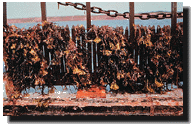
Traditional fishing activities have revolved around
shellfish and molluscs but, over the past fifty years,
new fisheries have emerged to cater to special markets
overseas or in the processing sector.
One such commodity is Irish moss, a tiny marine plant
that has a shape resembling moose antlers. It grows in
the ocean, from Newfoundland to New Jersey and from
northern Norway to Spain. In most places, it grows with
other seaweeds but only in Prince Edward Island does it
grow in high concentrations, in the absence of competing
species. It is especially abundant in the waters
surrounding western Prince Edward Island, near Miminegash
and Tignish.
“Storm toss,” free-floating moss broken loose
from the bottom of the sea by a storm, is most often
harvested using workhorses. The horses do work that
tractors or boats could never accomplish—providing
power in the rough, chest-deep swells of the Gulf of St.
Lawrence after a storm. The horses drag scoops through
the surf, catching the floating moss, and pile it on the
shore, where it is shovelled onto trucks or trailers. In
calm waters, boats drag for moss up to several hundred
metres off shore. Sometimes, moss pickers can simply fork
the moss into the trunks of their cars when the moss
rolls up on shore. Since dried moss fetches a better
price than the wet product, the moss pickers take their
harvest home and lay it out to dry on any available
space—lawns, fields, driveways, and back roads.
 Irish
moss is most often harvested directly, raked from the sea
floor. Long rakes are dragged from lobster boats which
haul 3,000 to 5,000 pounds of moss per day. This method
is restricted, however, as it has the potential to harm
other fisheries by disrupting animals and their habitat.
Lobsters especially tend to inhabit the rocky bottom of
the sea, hiding among the weeds.
Irish
moss is most often harvested directly, raked from the sea
floor. Long rakes are dragged from lobster boats which
haul 3,000 to 5,000 pounds of moss per day. This method
is restricted, however, as it has the potential to harm
other fisheries by disrupting animals and their habitat.
Lobsters especially tend to inhabit the rocky bottom of
the sea, hiding among the weeds.
The moss is then sold to processors who, using a
complicated process involving soaking the plants in
alkaline hot water and filtering it, extract a substance
called carrageenan. Whether we are aware of it or not,
all of us consume Irish moss almost every day. The
extracted carrageenan is used to bind, gel, thicken,
stabilize, or suspend particles in a wide variety of
foods, cosmetics, and industrial products. It suspends
colour pigments in water based paints, prevents the cocoa
in chocolate milk from settling to the bottom, binds
toothpaste and gives it its sheen, makes ice cream
consistent and creamy, and helps whipped cream hold its
shape.
Another weed growing in waters around Prince Edward
Island, furcellaria, is harvested around the eastern end
of the Island. It contains a brown carrageenan that is
used most often as a clarifier in beer.
Approximately ten Island fishermen are licensed to
harvest sea urchins. About half of them operate out of
Tignish, where the urchin is most abundant. Harvests are
sold to a buyer-processor who then markets the product to
Japan, where urchin roe is considered a seafood delicacy.
In some areas, suction harvesters are used to fish the
urchin, whereas in other parts of the Island, fishermen
hire local divers who work for a share of the harvest.
Aquaculture | Lobster | Shellfish | Finfish
